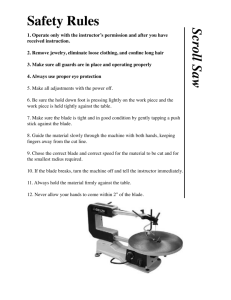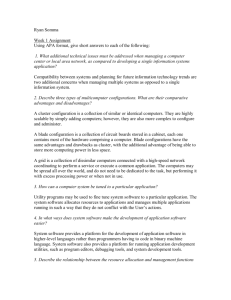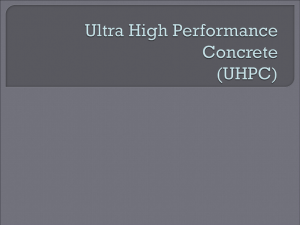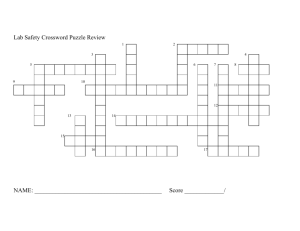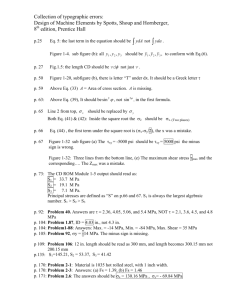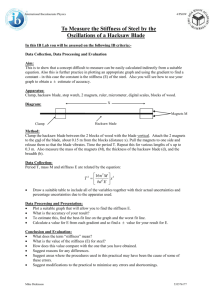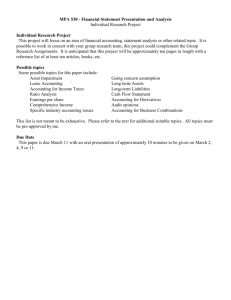8.2.1 Materials
advertisement
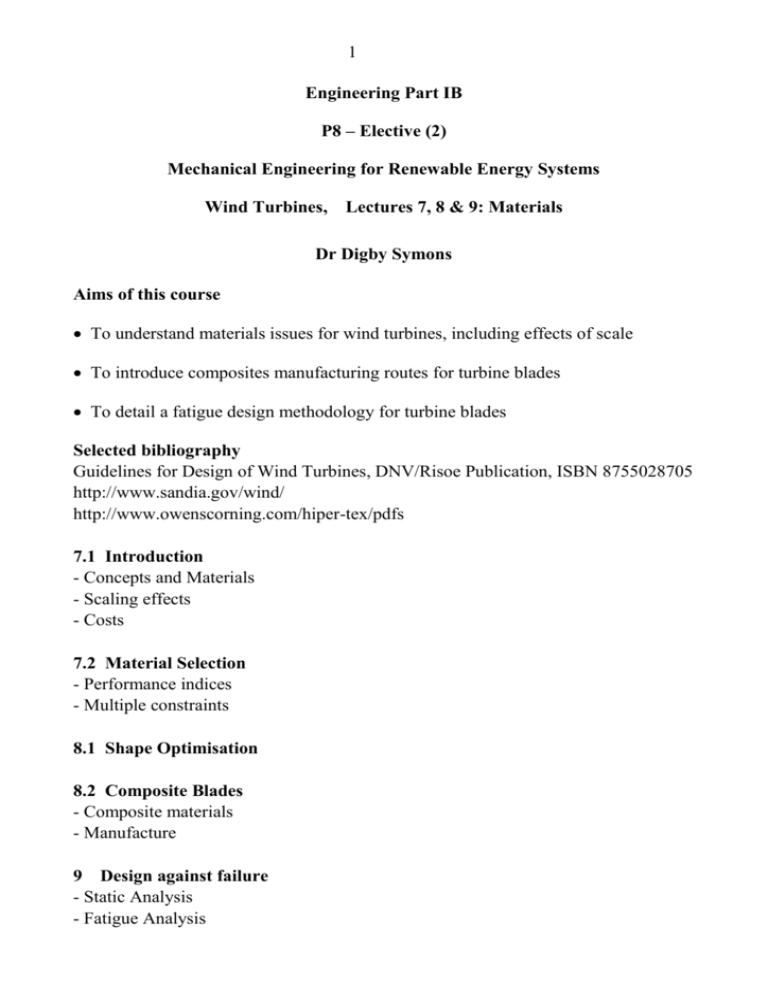
1 Engineering Part IB P8 – Elective (2) Mechanical Engineering for Renewable Energy Systems Wind Turbines, Lectures 7, 8 & 9: Materials Dr Digby Symons Aims of this course To understand materials issues for wind turbines, including effects of scale To introduce composites manufacturing routes for turbine blades To detail a fatigue design methodology for turbine blades Selected bibliography Guidelines for Design of Wind Turbines, DNV/Risoe Publication, ISBN 8755028705 http://www.sandia.gov/wind/ http://www.owenscorning.com/hiper-tex/pdfs 7.1 Introduction - Concepts and Materials - Scaling effects - Costs 7.2 Material Selection - Performance indices - Multiple constraints 8.1 Shape Optimisation 8.2 Composite Blades - Composite materials - Manufacture 9 Design against failure - Static Analysis - Fatigue Analysis 2 7.1 Introduction 7.1.1 Blade materials www.reuk.co.uk LM Glasfiber: A 61.5 m blade on its way to an installation 25 kms off Scotland. NEG Micon NM82 1.5MW turbine. 40m blades, vacuum infusion www.otherpower.com 3 7.1.2 Tower construction [Risoe/DNV] Sandwich construction 7.1.3 Blade structural concepts [Thomson Aarlborg] [Thomson Aarlborg] Main spar carries flapwise bending moments Leading and trailing edge carry edgewise bending 4 7.1.4 Scaling Assume self-similar both of which scale with blade radius R and self-similar 5 Growth exponent n (Rn) Parameter Tip speed ratio R /V0 0 Angular velocity -1 Power P 2 Weight mgdr 3 Second moment of area I 4 Aerodynamic loading intensity FN 1 Total aerodynamic load FN dr 2 Aerodynamic root bending moment M N FN rdr 3 Aerodynamic stress max, aero M N do 0 I TT 2 Tip flap-wise deflection 1 Self-weight root bending moment M SW mgrdr Self weight stress max, sw 4 M sw b I NN 2 1 6 Weight reflects cost (but manufacturing and labour costs may not scale directly with weight) Changes in critical with increase in size: – Self weight more critical for larger designs (include CFRP at tip) – Tip deflection scales with size - may be critical Need to develop more efficient designs for large blades – Better use of materials – Cheaper manufacture Glass fibre blades [Sandia 2004-0073, Owens Corning/Hartman 2006] 7 7.1.5 Blade Costs adhesive root studs resin 50m blade breakdown: [Sandia 2003-1428] fibreglass core Weight Total= Material cost Total = Majority of weight taken by All costs Total = Weight proportions reflect typical fibre volume fractions (in the range 50-60%) Significant Blade Costs 10-15% of installed capital cost (Sandia 2004-0073) 8 7.2 Materials Selection - Spar design Concept Blade length L Storm loading Beam depth 2d with spar caps width b, thickness t Uniformly distributed load W Example data: L = 35 m, W = 140 kN, b = 0.5m, d = 0.25m, = 3.5m Constraints STIFFNESS WL3 Tip deflection 8EI SIZE Maximum thickness t = d/5 Fixed Depth d, width b Free Thickness t Mass m 2tbL , 2nd Moment of Area 7.2.1 Merit Index based on deflection constraint Eliminate free variable thickness t WL3 WL3 8EI 16Etbd 2 m 2tbL 2 WL3 16 Ebd 2 bL Minimise mass, maximise Minimise cost, maximise WL4 8Ed 2 E E C m 120 109 E (SI units) I 2tbd 2 9 Aluminium CFRP GFRP Wood Cost Cm (£/kg) 4* 20 8 4 E (GPa) 70 140 45 20 100 800 100 20 f (MPa) 2700 1500 1900 700 (kg/m3) 26 93 24 29 E (×106) 6.5 4.7 3.0 7.1 E Cm (×106) 4600 1300 5100 4200 m (kg) 9300 640 6500 12000 m (kg) *Aluminium costs underestimate manufacturing complexity? 7.2.2 Thickness constraint WL3 WL3 WL3 E 8EI 8I 16tbd 2 E 5WL3 16bd 3 5 140,000 353 16 3.5 0.5 0.253 Include constraint on t=d/5: = 69 GPa Sensitive to Longer blades may be impractical for wood and GFRP - include 7.2.3 Multiple constraints Include stiffness and fatigue limit f Md WLd WLd I 2I 4tbd 2 at root Use tabular approach WL t 4bd f and therefore m 2tbL WL2 343 106 (SI Units) 2 f d f Choose material which meets both constraints at minimum Cost is critical - need to model this accurately and include manufacturing costs between blade cost and weight (lower weight reduces other costs) 10 11 8.1 Shape Optimisation - Can use ad hoc method to put material where it is needed. - Analysis for spar design but also relevant for tower design. Concept Assume a triangular plan form and depth profile d(x) d x d0 L Note that the spar breadth b does not need to be the same as the blade width. Consider a storm loading situation with the turbine not rotating. A total wind load W is distributed as a uniform pressure over the blade. How should we optimise the spar by changing the spar thickness t and breadth b as a function of position ? Tapering options We will assume that the spar thickness t is much less than the depth 2d, so that the relevant geometric change is the spar. Consider three options for spar area as a function of position x from tip: Constant area (e.g. constant spar width and thickness – not practical at tip?) A A0 x L Linear tapered area (e.g. linearly tapering width, constant thickness) A A0 Quadratical tapered area (linearly taper width and thickness) x A A0 L In general x A A0 L n with n = 0, 1 and 2 for constant, linear and quadratic tapers. A0 is a free variable chosen to match the materials and constraints. 2 12 Structural analysis L Mass m Adx 0 WL x M x 3 L I x 2 A0 n L n x dx L 0 A0 Ln 1 n 1 L n A0 L n 1 3 n 2 A 2 x x x d Ad 2 A0 d 02 A0 d 02 2 L L L 3 3 Md WL x d WL x x x 2 I 3 L Ad 3 A0d 0 L L n n2 x L assuming t << d 1 WL x 3 A0d 0 L 2n Strength constraint: Note that, for n = 2, the stress is constant in the spar along the length of the blade. For n = 0 or 1 the stress is a maximum at the blade root (x = L). Putting max f and eliminating the free variable A0 , the mass m can be obtained: f WL WL A0 3 A0 d 0 3d 0 f Hence m A0 L n 1 WL2 3d 0 f n 1 Minimum mass is obtained with n = 2 (note that this is the constant stress case). 13 Deflection: d2y d2y dx 2 M 2 EI dx For n = 0 M : integrate twice to find tip deflection EI WL x 3 L 3 1n x n 2 2 L 3EA0d 0 x EA0 d 02 L WL 1n x C L d2y x C L dx 2 integrating twice and putting in appropriate boundary conditions at x = L : dy 0 ,y=0 dx dy C x 2 L2 therefore dx L 2 2 and y C x 3 2 L2 x L3 2 L 3 3 WL3 CL2 so at x = 0 the tip deflection = 3 9 EA0 d 02 For n = 1 therefore d2y dx 2 C dy C x L and dx and the tip deflection For n = 2 therefore d2y x C 2 L dx 1 x2 L2 y C Lx 2 2 WL3 CL2 = 2 6 EA0 d 02 L C x dy CLln x ln L and dx dy CL x ln x x x ln L L dx so at x = 0 the tip deflection CL2 = WL3 3EA0 d 02 14 Stiffness constraint The tip deflection constraint gives a constraint on mass, again by eliminating A0 e.g. for n = 0 for n = 1 for n = 2 WL3 9 EA0 d 02 WL3 6 EA0 d 02 WL3 3EA0 d 02 A0 A0 A0 WL3 9 Ed 02 WL3 m 6 Ed 02 WL3 m 3Ed 02 m and A0 L 2 A0 L 3 A0 L 1 m m m WL4 9 Ed 02 WL4 12 Ed 02 WL4 9 Ed 02 Summary of results Shape parameter n 0 1 2 Strength constraint m 1/3 1/6 1/9 WL2 d 0 f Stiffness constraint m 1/9 1/12 1/9 Mass ratio m m Choose n 1/3 1 /2 1 WL4 Ed 02 f L2 Ed 0 which minimises the mass. For strength, this corresponds to n = 2 , for stiffness the best choice is n = 1 For the multiple constraint problem, which constraint is critical depends on the ratio f L2 of the masses required to meet each of the constraints and hence on Ed 0 15 fL m > 3, >1 for n = 0, 1 & 2 so STIFFNESS is critical – choose n = 1 Ed 0 m 2 For f L2 m For < 1 , <1 for n = 0, 1 & 2 so STRENGTH is critical - choose n = 2 Ed 0 m For 1 < f L2 Ed 0 < 3 both constraints may be active f L2 100 352 2 e.g. for the example blade using Aluminium Ed 0 70,000 0.25 3.5 Increasing m/m m>m Stiffness limited, choose n = 1 0.1 f E 0.01 m<m Strength limited, choose n = 2 0.001 10 m/m n2 100 L2 d 0 0 1000 16 8.2 Composite Blade Design • • • • • High specific stiffness and strength Complex shapes viable Corrosion resistance Smooth surface Low maintenance 8.2.1 Materials Fibres – unidirectional material – multidirectional laminates – random mat – carbon, glass, wood Matrix: – infusion – pre-impregnation – e.g. epoxy, polyester Composites Glass fibre reinforced plastic – GFRP Carbon fibre reinforced plastic –CFRP Wood laminate, e.g. birch, Douglas fir Hybrids (zebrawood = GFRP + CFRP + wood) CFRP and wood are well matched in failure GFRP and CFRP are not well matched in failure strain Sandwich panels Fibre orientations: Owens Corning 2006/DeMint 17 8.2.2 Processes Hand lay-up Layup on mould Dry or pre-preg material Vacuum bag to consolidate Curing - room temperature, radiant heaters [Mayer, 1992] Resin transfer moulding Closed mould process Charge mould with dry fabric Inject thermoset resin at relatively low pressure [Astrom, 1997] 18 Vacuum injection moulding Open or closed mould Use vacuum bag with open mould Vacuum forces resin through reinforcement LM Glasfiber Astrom, 1997 LM Glasfiber polyworx.com 19 Blade production routes [Owens Corning 2006/DeMint et al] 20 8.2.3 Stiffness Overall laminate stiffness made up by contributions from each ply Carpet plot [Bader] gives Young's modulus as a function of percentage of plies in plies (assume only these directions) e.g. Unidirectional material (100% : 0°): E = Stiffest, but suffers from cracks along fibres. Include 'off-axis material' e.g. (50% 0°, 50% 45°): E = Same ply, now in transverse direction (50% 45°, 50% 90°): E = All three ply directions (40% 0°, 40% 45°, 20% 90°,): E = 21 9 Design against failure Blade field failures [Owens Corning/Hartman 2006) Study of 45 blades: NA Windpower P34 V1 N12 Jan 2005 [SNL/Corning 2006] Testing LM Glasfiber test bed. 22 9.1 Static failure Unidirectional laminate Use failure stress or strain, which depends on direction of loading CFRP GFRP 1500 1100 + (MPa) 1200 600 - (MPa) 1.1 2.8 e+ (%) 0.9 1.5 e- (%) Failure for loading along fibre direction of typical unidirectional laminate Multidirectional laminate Can calculate individual ply stresses and compare failure modes Easier, though less accurate, to use a laminate failure strain The failure strain corresponds to failure of the ply with the smallest strain to failure. CFRP GFRP 0.4 0.3 e+ (%) 0.5 0.7 e- (%) Multidirectional laminates e.g. Strength of unidirectional GFRP in tension = 1100 MPa Strength of (50% 0°, 50% 45°) GFRP laminate = E e+ = Knock-down factors Need to include many knock-down factors (e.g. up to factor of – manufacturing – ply drops – holes – joints 23 9.2 Fatigue failure S-N curve for unnotched strength Increasing applied stress range S decreases lifetime (note whether range or amplitude are quoted) S N S0 M Effect of fluctuating stress levels - Miner's rule The component fails when the proportion of the life time used by each block adds up to one Ni 1 (Data Book) i.e. (10) N fi i Nfi is the number of cycles that you would need for failure with the stress range and mean stress of the ith block. Effect of mean stress – Goodman's rule For the same fatigue life, the stress range operating with a mean stress m is equivalent to a stress range 0 and zero mean stress, according to the relationship 0 1 m (Data Book) ts (11) where ts is the tensile strength (i.e the mean stress giving no fatigue life) Can take ts as the stress amplitude S0/2 for one cycle from the S-N data. m 0 No allowable stress range when mean stress equals the failure strength ts m 0 24 Load cycle assessment Need statistics to model loading and failure with random wind loading e.g. WISPER spectrum widely used in Europe (Wind SPEctrum Reference) Convert wind and self-weight load to stress cycle via structural model Typical wind speed data, Texas [Sutherland and Veers 1995] Rainflow counting Need to identify cycles of load within random signal [Wirshing and Shehata/DNV Risoe] 25 s(t) Imagine rain flowing down the pagoda roof Rainflow initiates at each peak and trough and drips down When a flow-path started at a trough comes to the tip of the roof, the flow stops if the opposite trough is more negative than that at the start of the path under consideration [(1-8], [9-10]. A path started at a peak is stopped by a peak which is more positive than the peak at the start of the path [2-3], [4-5]. If rain flowing down a roof intercepts a previous path, the present path is stopped [3-3a], [5-5a] A new path is not started until the path under consideration is stopped Half cycles of loading are projected distances on the stress axis [1-8], [3-3a], [55a] Each peak-originated half-cycle is followed by a trough originated half-cycle of the same range for (i) long stress histories (ii) short stress histories if the first and last peaks have same magnitude 26 Typical load spectra NPS 100 kW Turbine SAND99-0089 Alternating stress (MPa) Mean Stress (MPa) SAN99-0089 Wind farm spectrum on Micon 65kW turbine Numerical characterisation of loading Divide spectrum into bins (minimum 50) Alternating stress (MPa) Mean Stress (MPa) 0-20 20-40 40-60 0-50 50-100 100-150 27 Analytical characterisation of loading Various forms available giving probability of load S e.g. Weibull distribution of probability density function ( S ) 1 S exp S S S is the mean of the stress amplitudes No effect of mean stress on fatigue life Additional parameter is the rate of loading (number of load cycles per unit time) or total number of cycles Fatigue life - S-N data Need to include variability in tests and material Can fit data by relationship S N S0 M S0 (MPa) M Fatigue Limit (MPa) Glass fibre 300 10 50 CFRP 1500 40 800 Wood 50 20 20 Typical fatigue data (varies significantly within each material group) [Sandia 99-0089] 28 Fatigue failure prediction Numerical Illustrated by example, with M = 10, S0 =ts = 300 MPa Mean Stress (MPa) Alternating stress (MPa) 0-5 0-5 5-15 15-25 5-10 10-15 n Number of cycles in time block T For each bin Goodman's rule: include effect of mean stress 0 1 m 0 S ts S-N data: find life time Nfi from this load S N fi S0 M 10.08 300 10 5 1014 Miner's rule: proportion of lifetime by this block of time = Sum the effects of all the bins Sum the proportion of the lifetime used up by all the bins - say Then the number of repeat blocks = 1/ and the lifetime of the component = 29 Analytical Failure when the life used up by contributions at different stresses sums to one using Miner's rule, where Ntot is the total number of cycles is the number of cycles in the stress range S NTot S NTot 1 dS M S M exp S S dS NTot S N f S S0 S 0 0 0 z z 1 t t e dt 0 m m 1 is the Gamma function, equal to (z-1)! for positive integers. Normalised scales S0 = 300 MPa, S =10 MPa, m = 10 Nf = 1.6×108 scales Frequency () 0 Damage contribution (/Nf) 50 100 150 200 Stress range S (MPa) Effect of extreme loads dominates – need to get better estimate of loading – very sensitive to power exponent 250 300 in damage law and to Analytical solution not valid when damage due to stresses greater than S0 become significant (any load above the static failure load will cause failure)
